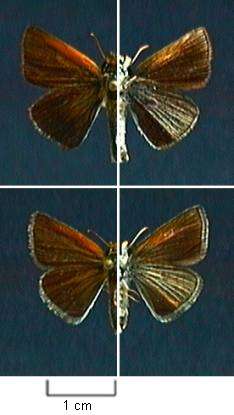
Fathom Five National Marine Park is a National Marine Conservation Area in the Georgian Bay part of Lake Huron, Ontario, Canada, that seeks to protect and display shipwrecks and lighthouses, and conserve freshwater ecosystems. Parks Canada has management plans for the aquatic and terrestrial ecosystems, with a multi-action plan for species that are at risk, including endemic species, the Monarch butterfly, the eastern ribbonsnake, and the eastern whip-poor-will. The aquatic ecosystems in the park are also of particular interest. Many fish, shellfish, amphibians, and eels are an attraction for naturalists in the park. Much of this wildlife is accessible to scuba divers and snorkellers in the park. The many shipwrecks make the park a popular scuba diving destination, and glass bottom boat tours leave Tobermory regularly, allowing tourists to see the shipwrecks without having to get wet. Additionally, there are three main popular hiking trails found within Fathom Five National Marine Park that provides visitors with views of old growth forests and the Georgian Bay. The Saugeen Ojibway Peoples have inhabited the Bruce Peninsula and the area that is now Fathom Five National Marine Park for thousands of years. This land provided for their communities and their people with the plethora of wildlife and plant life. They provide the local knowledge about Lake Huron and its ecological value to the reserve, park, and their overall livelihood. Parks Canada and Saugeen Ojibway People's collaboration is said to yield a benefit to both parties with regard to overall ecosystem knowledge.

Erynnis is a genus in the skippers butterfly family Hesperiidae, known as the duskywings. Erynnis is found in the Neotropical realm and across the Palearctic, but the highest species diversity is in the Nearctic. The genus was erected by Franz von Paula Schrank in 1801.

The Hine's emerald is an endangered dragonfly species found in the United States and Canada. Populations exist in Illinois, Michigan, Missouri, Ontario, and Wisconsin. Larvae are found in shallow, flowing water in fens and marshes, and often use crayfish burrows. Major threats to the species include habitat loss and alteration, and the species is legally protected in both the United States and Canada.

The deepwater sculpin is a species of freshwater fish in the family Cottidae of order Scorpaeniformes. It is a glacial relict, native to a limited number of deep, cold lakes in Canada and the United States.

The Peary caribou is a subspecies of caribou found in the High Arctic islands of Nunavut and the Northwest Territories in Canada. They are the smallest of the North American caribou, with the females weighing an average of 60 kg (130 lb) and the males 110 kg (240 lb). In length the females average 1.4 m and the males 1.7 m.

Lupinus perennis is a flowering plant in the family Fabaceae.

Paetulunio fabalis, the rayed bean, is a species of freshwater mussel, an aquatic bivalve mollusk in the family Unionidae, the river mussels. It is the only species in the genus Paetulunio, and was formerly classified in Villosa until a 2018 study.

Lampsilis fasciola, the wavy-rayed lampmussel, is a species of freshwater mussel, an aquatic bivalve mollusk in the family Unionidae, the river mussels.

Erynnis brizo, the sleepy duskywing or banded oak duskywing, is a species of Hesperiidae butterfly that occurs throughout North America and is commonly confused with E. juvenalis and E. lucilius. The species is listed as threatened in Connecticut and Maine.

Erynnis persius, commonly known as Persius duskywing, is a species of butterfly in the family Hesperiidae that occurs in North America. The eastern subspecies Erynnis persius persius is rarer and protected by law in some regions.

Erynnis horatius, commonly known as Horace's duskywing, is a species of butterfly in the family Hesperiidae. It is found in the United States from Massachusetts to Florida, and west to eastern South Dakota, the Gulf Coast, south-eastern Utah, Colorado, north-eastern Arizona, and New Mexico. It is listed as a species of special concern in the US state of Connecticut.

Ceanothus americanus is a species of Ceanothus shrub native to North America. Common names include New Jersey tea, Jersey tea ceanothus, variations of red root, mountain sweet, and wild snowball. New Jersey tea was a name coined during the American Revolution, because its leaves were used as a substitute for imported tea.

Erynnis pacuvius, also known as Pacuvius duskywing, Dyar's duskywing or buckthorn dusky wing, is a species of skipper butterfly in the family Hesperiidae. It is found in southern British Columbia and in most of the western United States.

Oarisma poweshiek, the Poweshiek skipperling, is a North American butterfly in the family Hesperiidae (skippers), subfamily Hesperiinae. The range of this species in Canada is restricted to southeastern Manitoba, and in the United States it historically ranged from the Dakotas to the southern Lower Peninsula of Michigan.

Ceanothus herbaceus, also known as Jersey tea, is a species of shrub in the family Rhamnaceae and is similar to Ceanothus americanus and Ceanothus sanguineus. It is a perennial shrub which is native to North America.
Vaseux-Bighorn National Wildlife Area is a National Wildlife Area in British Columbia, Canada, primarily set aside to protect winter rangeland for California bighorn sheep. In 1979, the Vaseux-Bighorn Wildlife Area was established in response to substantial reduction in wild animal populations in the area. Identified factors contributing to species decline at the time were high predator population, overharvesting of species, and illegal hunting. Land development, cattle raising, and lumbering also might have altered species populations. Under these conditions, the area was able to be classified as a Category IV area by the IUCN and is now used for wildlife habitat and conservation. Even with minimal anthropogenic use of the area, threats persist through invasive species. Recreational use is limited spatially and is only open to the public during the day.
















